#fan eng/the official/and the official in french
Note
^_^ hiiii!! I was wondering what milgram is? It seems interesting and I kinda want to get into it- but I’m not really sure what it is 😭😭😭 ???? Idk if this is weird you’re like the only person I can ask <//3
HI HI basically milgram is a music project about ten prisoners and all of them have committed "murder" of some sort. the whole point of the project is that we have to vote the prisoners innocent or guilty (or, to be more accurate, "forgivable" or "unforgivable" since all of them are guilty of murder, our job is to decide whether their murders can be forgiven or not). you can vote using the official app or the official website. the plot changes depending on the audience's verdicts and the project is supposed to have three seasons or "trials" and we're getting close to the end of the second season since the last mv came out today. we don't know what is going to happen to the prisoners in the end which also makes it even more scary.
the voting process goes like this: the prison guard (the protagonist or our "self-insert" to be more exact. they are supposed to represent the audience) uses a music video extraction machine on the prisoners (not even kidding) and we can see some details about their crimes in their music videos. we're supposed to make theories about the videos and we are free to interpret them in any way we want and there isn't really a "wrong" way to vote someone. you can literally vote someone innocent or guilty based on their character design. all music videos can be watched on the official youtube channel and they also have english subtitles (and they've also started adding more languages recently like french) and there are also voice dramas which are very important for understanding the characters better, we don't have the official eng translations, but there are a lot of fan translations which can be found online.
hopefully that helps, i'm sure there are people who can explain it better but i wanted this to be easy to understand and not too overwhelming <3
8 notes
·
View notes
Note
Hello tumblr user coffee-without-anesthetics can you explain Miligram to me like I'm your 80 year old grandmother who doesn't understand why she needs to decide why she needs to either vote to "forgive or do not forgive" this nice-looking lad/lass when you handed the phone to her and told her to tap the button you pointed out
hello!!! yes i can tumblr user kayoi1234, but too bad you're getting the full recap (miligram made me giggle, nice)
alright so we've got 10 buddies (prisoners) in this Milgram prison who are all technically guilty of "taking a life" (not killing someone, only around four of them did that from what we know.)
in the beginning, this is all the info available.
there's 3 trials over the course of years, 1 of which already fully passed, the second of which is more-or-less on the edge being finished -> as im writing this, you can vote for 2 characters, and the last 2 are yet to be judged at all
during each trial:
the official youtube channel releases a new MV (song) about the character currently being judged. (and a cover of a deco*27 song on spotify)
a voice drama of a discussion between the character and the warden (Es) is uploaded on spotify. an english translation by fans is usually uploaded not long after on youtube
and later, when both of the above has been realized for two characters
interrogation questions are answered on twitter. (here's the fan eng account)
INFO 1: in official sources (website etc) they use "guilty or innocent". this is misleading. they're all guilty of something. the only question is your forgiveness.
INFO 2: the official english translations of the songs sometimes Suck Major Ass (see: Undercover), but theyre fine enough most of the time.
now that we're onto trial2 we know what an unforgiven vote does, which is: less privileges/freedom, more restrains, mental state done did fucked up if they care, more but can't remember right now.
in-universe, the warden judges them. you influence the judgement with daily votes.
and the most important of all: any reason to judge is a good reason!!
unforgiven cause you think they're reprehensible? sure! forgiven cause theyre cute? yeah! forgiven for the lolz? why not!
…there's also the question if this all is technically a infohazard because by knowing about the vote and then abstaining from voting (or not doing anything at all) is still participating anyway.
TLDR: over time you get more info about 10 characters who all took a life, and with that info you decide whether you forgive them or not in three trials
if you wanted basic info you can stop here.

diversity win! the amnesiac nonbinary 15 y/o prison warden with identity issues can hear the voice anyone who's ever voted! neat!
in the beningening, no one knew what an unforgiven vote would do and the info we had about characters was spotty at best, but we still got 4 characters judged unforgiven.
now more fun stuff!!
(im gonna use prisoner numbers not names cuz i don't wanna type allat)
unrelated: there's a side spin-off manga (???) called minigram. i have no idea what goes on there.
random facts: 04 is half-french and the daughter of a landlord. 09 got diagnosed with DID via talking rabbit and teenager. 03 is the twitter-using guy who doxxed a kid to death. there's a fucking smokers club (05, 07 and 09). fun stuff all around
the thing is that the literal last character of the roster to be judged is a Justice Fanatic who got forgiven!! guess what she did to those who weren't.
long story short she got 03 blind in one eye, 06 now has a broken arm + bruised ribs + concussion iirc, 08 is a kid so she got skipped, and 09 fought back but you can see it took a lot.
why aren't any of them dead? the resident medic 05 was judged forgiven so he was free to help them.
there's no conclusion, *gestures at all of them* i just think they're neat
#feel free to ask for specifications and i'll answer to the best of my ability#thing i didn't mention anywhere but still kinda important: you need a twitter account linked to the site to vote#the talking rabbit is called Jackalope. didnt mention him in the post because i didnt find a place to fit him into.#as you can see i have been insane about this for a long time (since february) so i've got a lot to say#it's a fun side-thing to think about#and you get music out of it! which slaps btw listen to Cat and Purge March and Backdraft and and and#kayoi1234#milgram#post anesthetics posts#an asker asked an ask
8 notes
·
View notes
Text
Araki Interviews/JoJo Exhibit Footage:
1980 -- Araki meeting Osamu Tezuka (author of Astro Boy)

1993 -- Interview about the upcoming JoJo OVA
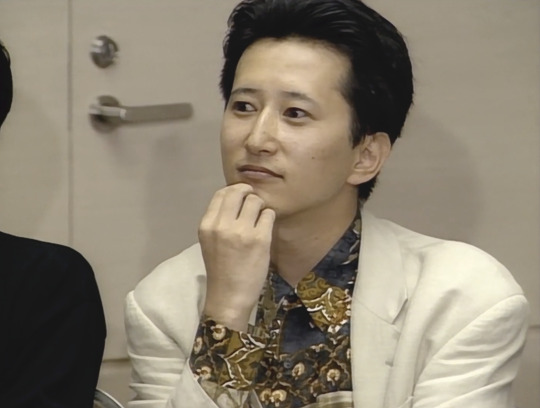
1993 -- Araki Interview (without eng subtitles) JoJo OVA DVD--includes Araki drawing Josuke

2003 -- French NoLife interview for Araki's exhibition in Paris
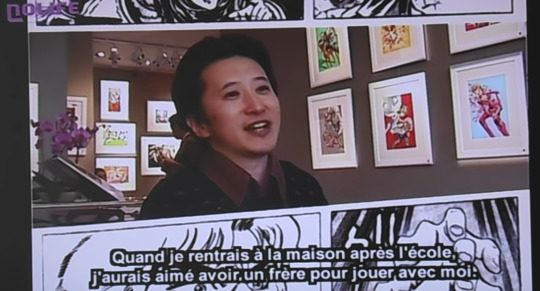
2003 -- Les Dossiers Du Manga interview

2006 "Special Interview with Hirohiko Araki" (around the time the Phantom Blood PS2 game came out) PART 1 PART 2 PART 3

2006 -- Araki interviewed by Shoko Nakagawa with ENG captions: PART 1 PART 2 PART 3 (full interview without captions here)

2008 upload date - in the video, Steel Ball Run was still being published -- Interview with Araki about JoJo in general
2009 -- 100 questions with Araki-sensei PART 1 PART 2 PART 3 PART 4 PART 5 (PART 6 missing)

September 2011 -- fan footage of the JoJo/Rohan x Gucci collab store display

October 2011 -- more footage of the JoJo Gucci Tokyo display
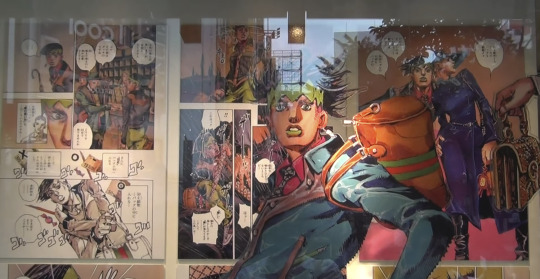
July 2012 -- Q & A with Araki for the "Hirohiko Araki Original Art Exhibition Jojo Exhibition"

July 2012 -- Araki teaches a college class how to draw and has them design characters, talks about the JoJo design process and some art history references. PART 1 PART 2
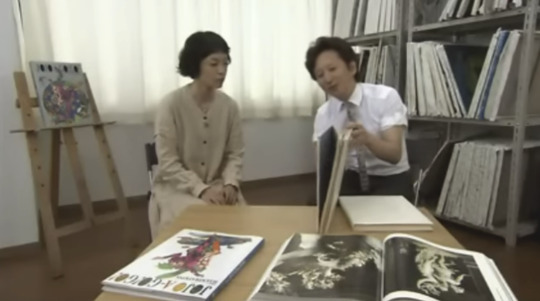
September 2013 -- Jojoveller Disk 2 -- Short Video "Making of JoJo"
September 2013 -- Araki hour long timelapse of fully drawing and painting the Jojoveller illustration
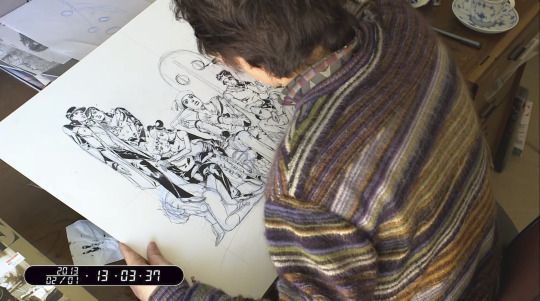
August 2014 -- Araki Official ALS ice bucket challenge video

August 2014 -- SPUR Love Mode 100 -- Araki talking about his gucci ipad case and how he stores a sketchbook inside

Nov 2014 -- fan video of the Jojolion Exhibition at Lucca Con

July 2016 -- fan video of Araki's Anime Expo message
December 2016 -- Jump Ryu (1x speed, hour and a half, Araki drawing Jojolion) ( extremely sped up short version )
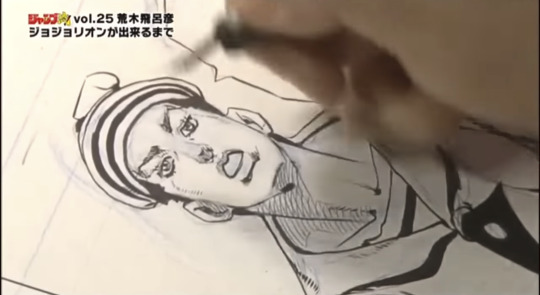
Anime Expo 2017 Greeting from Araki-sensei
October 2017 -- VIZ: Araki's favorite fashion designers/the fashion of JoJo

JoJo exhibition 2018 trailer
2018 Ripples of Adventure exhibition interview and tour

September 2018 -- UOMO magazine "5 strange questions for Araki" and Bruno fashion drawing

January 2020 -- VIZ: Araki on Diamond is Unbreakable
October 2020 -- VIZ: Araki on Golden Wind
April 2021 -- screen record of Araki's message from the Stone Ocean press conference livestream
June 2022 -- Popcult Japan Interview

Summer 2022 -- VIZ: Summer Greeting from Araki Special Jolyne Illustration Special Anniversary Message

40 notes
·
View notes
Text
[PDF] Download Damnation Island: Poor, Sick, Mad, and Criminal in 19th-Century New York PDF -- Stacy Horn
Damnation Island: Poor, Sick, Mad, and Criminal in 19th-Century New York - Stacy Horn
READ & DOWNLOAD Stacy Horn book Damnation Island: Poor, Sick, Mad, and Criminal in 19th-Century New York in PDF, EPub, Mobi, Kindle online. Free book, AudioBook, Reender Book Damnation Island: Poor, Sick, Mad, and Criminal in 19th-Century New York by Stacy Horn full book,full ebook full Download.

Read / Download Damnation Island: Poor, Sick, Mad, and Criminal in 19th-Century New York
DESCRIPTION BOOK : Today it is known as Roosevelt Island. In 1828, when New York City purchased this narrow, two-mile-long island in the East River, it was called Blackwell?s Island. There, over the next hundred years, the city would send its insane, indigent, sick, and criminal. Told through the gripping voices of Blackwell?s inhabitants, as well as the period?s city officials, reformers, and journalists (including the famous Nellie Bly), Stacy Horn has crafted a compelling and chilling narrative. ?Damnation Island recreates what daily life was like on the island, what politics shaped it, and what constituted charity and therapy in the nineteenth century. Throughout the book, we return to the extraordinary Blackwell?s missionary Reverend French, champion of the forgotten, as he ministers to these inmates, battles the bureaucratic mazes of the Corrections Department and a corrupt City Hall, testifies at salacious trials, and in his diary wonders about man?s inhumanity to man. ? For history fans, and
DETAIL BOOK :
Author : Stacy Horn
Pages : pages
Publisher : Highbridge, a Division of Recorded Books
Language : eng
ISBN-10 : B07CS7G67X
ISBN-13 :
Supporting format: PDF, EPUB, Kindle, Audio, MOBI, HTML, RTF, TXT, etc.
Supporting : PC, Android, Apple, Ipad, Iphone, etc.
================*================
Tag the PDF
- Damnation Island: Poor, Sick, Mad, and Criminal in 19th-Century New York by Stacy Horn Ebook PDF
- Damnation Island: Poor, Sick, Mad, and Criminal in 19th-Century New York by Stacy Horn PDF Download
- Damnation Island: Poor, Sick, Mad, and Criminal in 19th-Century New York by Stacy Horn EPUB
- Damnation Island: Poor, Sick, Mad, and Criminal in 19th-Century New York by Stacy Horn EBOOK
- Damnation Island: Poor, Sick, Mad, and Criminal in 19th-Century New York by Stacy Horn PDF Online
- Damnation Island: Poor, Sick, Mad, and Criminal in 19th-Century New York by Stacy Horn E-BOOK Online
- Damnation Island: Poor, Sick, Mad, and Criminal in 19th-Century New York by Stacy Horn PDF Free
- Damnation Island: Poor, Sick, Mad, and Criminal in 19th-Century New York by Stacy Horn ebook library
- Damnation Island: Poor, Sick, Mad, and Criminal in 19th-Century New York by Stacy Horn pdf document
- Damnation Island: Poor, Sick, Mad, and Criminal in 19th-Century New York by Stacy Horn pdf reader
- Damnation Island: Poor, Sick, Mad, and Criminal in 19th-Century New York by Stacy Horn ebook creator
- Damnation Island: Poor, Sick, Mad, and Criminal in 19th-Century New York by Stacy Horn ebook deals
- Damnation Island: Poor, Sick, Mad, and Criminal in 19th-Century New York by Stacy Horn ebook kindle
- Ebook PDF Damnation Island: Poor, Sick, Mad, and Criminal in 19th-Century New York by Stacy Horn
- PDF Download Damnation Island: Poor, Sick, Mad, and Criminal in 19th-Century New York by Stacy Horn
- EPUB Damnation Island: Poor, Sick, Mad, and Criminal in 19th-Century New York by Stacy Horn
- EBOOK Damnation Island: Poor, Sick, Mad, and Criminal in 19th-Century New York by Stacy Horn
- PDF Online Damnation Island: Poor, Sick, Mad, and Criminal in 19th-Century New York by Stacy Horn
- E-BOOK Online Damnation Island: Poor, Sick, Mad, and Criminal in 19th-Century New York by Stacy Horn
- PDF Free Damnation Island: Poor, Sick, Mad, and Criminal in 19th-Century New York by Stacy Horn
- ebook library Damnation Island: Poor, Sick, Mad, and Criminal in 19th-Century New York by Stacy Horn
- pdf document Damnation Island: Poor, Sick, Mad, and Criminal in 19th-Century New York by Stacy Horn
- pdf reader Damnation Island: Poor, Sick, Mad, and Criminal in 19th-Century New York by Stacy Horn
- ebook creator Damnation Island: Poor, Sick, Mad, and Criminal in 19th-Century New York by Stacy Horn
- ebook deals Damnation Island: Poor, Sick, Mad, and Criminal in 19th-Century New York by Stacy Horn
- ebook kindle Damnation Island: Poor, Sick, Mad, and Criminal in 19th-Century New York by Stacy Horn
0 notes
Text
VIXX Fancafe Level Up Tutorial (Updated 210705)
Sign into your daum fancafe account. (For help making an account, this tutorial should still work.
Scroll down to the Leve Up section and click here.

Click on the button here to open a new window of level up questions.

Here are the questions:
1. Nickname / Name / Gender / Date of Birth YYMMDD / Location
2. Write the VIXX members’ real names, birthdays, and blood type in order of their date of birth.
3. Write the name and birthday of VIXX’s symbol (robot).
4. Write the meaning of VIXX (in English and Korean).
(Here is the Korean: 최고의 목소리, 최고의 비주얼, 최고의 가치라는 뜻입니다.)
5. Write VIXX’s debut date.
6. List the album titles + title songs of VIXX 2016 CONCEPTION.
(ex_hyde + hyde → Jekyll + 대.다.나.다.너)
7. Below is VIXX’s song ( ① ). Fill in the blanks in order.
밤은 두려워도 ( ② ) 어둠은 무서워 그래도 우린 둘이니까
한 걸음 더 걸어갈래 저 끝까지 달려가볼래
내가 해줄래 네 ( ③ ) 더해주는 일 네 ( ④ ) 덜어주는 이 단 하나뿐인 삶
가장 찬란한 20대의 절반을 너와 ( ⑤ ) 빛나는 오늘
내일 더 빛나기에 더 아름다운 오늘 더 아름다운 ( ⑥ )
① 우리에게 ② 우린 하나니까 ③ 행복을 ④ 슬픔을 ⑤ 1818일째 ⑥ 오늘
8. Write the names of VIXX’s concerts in order. (Excluding fan meetings and showcases)
9. Write VIXX’s official fanclub name and colors.
10. Write two or more lines about what you hope for VIXX or admin. (No enter / no special characters / no excessive space / no spacing out characters)
11. If you violate any VIXX official fancafe notices, you may be warned or permanently banned, and if you change your nickname after being levelled up to one that violates the nickname rules, you will be demoted without prior notice. Do you agree with the above?
Now click the red button.

※ Make sure that your nickname follows the guidelines before leveling up.
Nickname Guidelines:
Character Limit
3-8 Hangul characters
6-10 English characters
When combining Korean and English: ENG characters=1byte, KOR characters=2bytes, and you must have 6-10 bytes
You may only use simple Hangul or English (or a combination)
No standalone consonants (ex: ㅋㅋ or ㅎㅎ) or “alien” language (ex. 얅얋)
No nonsense English or initials (ex. Sjfdkndfj)
No using languages other than Korean or English (ex. Japanese, Chinese, French, etc.)
When combining Korean and English, you must be able to read it (ex. love사랑 is fine, but a빅스a is not)
No special characters (ex: ♥, ~, ^^, ., -, _, etc), Chinese characters, or spaces
No nicknames that could be mistaken for the members or staff (including nicknames similar to VIXX)
No nicknames related to other groups or singers
No nicknames that are obscene, derogatory, contain curse words, contain coupling terms (T/N: OTP names), sexual, and/or feminize the members
Be sure to check for spelling errors
Feel free to contact me if you need help answering any of the questions!
17 notes
·
View notes
Text
[CN] Kiro’s R&S - Stunning Young Idol (Eng Translation)
🍒This R&S (惊艳的少年偶像领军人物) was part of the Dream Heart Lake event which will unlikely come to EN🍒
Context: An article in a Japanese magazine

Cancelled Kiro R&S:
> top experimental subject (by another user)
> stunning young idol ♡
> youthhood
> heaven’s home for children (by another user)
[ Chapter 1 ]
Our interview with Kiro went very pleasantly. No one who attended the interview disliked him. Even our photographer, who has always been averse to young male idols, was full of praise.
Come to think of it, it’s no easy feat for this child to maintain such a transparent and innocent heart in an industry where crooks mix with honest folks. Readers who know him are definitely aware that he debuted in France at the age of six.
Back then, he accepted an interview in Paris for a television program. His tiny frame was seated in the large sofa, his legs not long enough to touch the floor, and were dangling in the air.
Many people were afraid that we wouldn’t be able to find this precious video clip. It was only through the recording Agent Savin sent that we could obtain this young and tender moment of Kiro.
Although the video clip has already been kept by Kiro’s agency and not accessible to the public, I can disclose it slightly through this interview.
The person who interviewed Kiro was Eva Saidel, a French female singer who was tremendously popular for a time. The beautiful Eva had asked Kiro if he could perform a song for her. Young Kiro nodded, obedient and filled with a gentlemanly demeanour as he responded, “Yes ma’am.”
-
[ Chapter 2 ]
Kiro performed Beethoven’s “Moonlight Sonata”. It wasn’t surprising that he liked Beethoven - all pianists definitely like Beethoven.
Saidel asked if he knew how to play other instruments. He replied by saying he also knew the violin, but was afraid that his neck would become crooked if he kept practising it. Everyone at the scene started laughing. Ms Saidel laughed excessively as well, and it was evident that she liked this child very much.
At the time, Kiro was wearing an adorable checkered shirt and a small, adorable hat. He even wore an official-looking tie. His cute appearance was sure to attract the attention of many.
A large proportion of Europeans knew of a mixed-race child who spoke fluent French, and would occasionally appear on the television to sing for them, or play classical pieces. They also gradually knew that his name was “Kiro” - this was a stage name he called himself when he debuted.
Eva Saidel, who had once interviewed him, liked him very much. Kiro said that he would always remember Ms Saidel’s luxurious and spotlessly white mansion. He would sit on the sofa in the mansion and listen to the old albums played by Ms Saidel.
Saidel also hired an incredibly renowned celloist from France to teach Kiro how to play the cello. I think many people don't know about this period from his past.
As of today, Saidel is already in her sunset years, and still remains in contact with Kiro.
When Kiro held a concert in Paris last month, the first person he invited as a guest was Saidel. He also played the song “Träumerei” using the cello she gave him.
“Back then, it was as though I returned to my childhood years. Ms Saidel is very kind, like a mother. She is extremely giving towards me.”
-
[ Chapter 3 ]
After junior high school in France, Kiro listened to Ms Saidel’s advice and studied in a high school in California. The intelligent Ms Saidel predicted everything - Kiro’s talent would be discovered very quickly.
After one performance, he was signed on with the renowned Warner Music Company. At the time, he was in Year Three, but never forgot his homework, and even entered Berkeley University with stellar results.
By the time he was in Year 4 (in contrast to Japan, high school in America spans four years, while elementary school spans five), he had already formed a band and was touring in various places. Warner Music is an experienced company with incredible foresight, and they allowed Kiro to return to France to begin his music career.
The number of fans Kiro had in Europe was astounding. The women in Europe found his mixed-race looks and his breathtaking voice unforgettable. Their concerts drew large crowds, and it would sometimes be difficult to obtain tickets. 90% of the females were there for Kiro. Such attractive force was rarely seen.
Actually, when we were interviewing Kiro, we could also feel the charisma he exuded. It’s a kind of magic which renders people unable to resist.
With just a smile, he easily won our hearts.
We have no idea why that’s the case. Perhaps it’s because he’s Kiro.
-
On the topic of whether he gleaned anything from his four years in Berkeley University, Kiro spoke without reservation and commented that he felt a lot of stress as there were many elite students. Hence, he had to fork out even more effort than usual to face each examination.
When he was in Year Three, Kiro continued touring with the band. He disclosed that he used to do his homework on the plane. When his band was touring the entirety of Europe, his band members would spend their spare time exploring the picturesque towns while Kiro would be holding his books and revising in the hotel.
When we asked why he was so hardworking, he replied by saying that he didn’t want his professors to stop liking him because of a drop in his grades.
In reality, every teacher who has met him like him very much. But because of this, Kiro always remained in fear. From beginning to end, he felt that the love and care from people was akin to smoke - surging at first, but dissipates gradually.
-
[ Chapter 4 ]
Kiro told us that he had felt very scared when he made the sudden decision to return to China after graduating from university. After all, there were many excellent artistes in China, and he was afraid that he wouldn’t receive love from fans.
But reality is always unexpected. His act of returning to China to develop was extremely correct. It allowed people in Asia to notice his radiant light. The artiste from China that the media in Korea likes reporting on the most is Kiro. Every now and then, he would cause a sensation there, but they would be for issues that aren’t important.
In Japan, he truly stirred a sensation through “Three Kingdoms”, a movie he was in half a year ago. He played the role of Sun Ce.
“The History of the Three Kingdoms” enjoyed widespread popularity in Japan.
This movie adaptation of “Three Kingdoms” was incredibly well received in Japan, and everyone was enthusiastic about the contents of the movie.
Even now, Kiro can recall how life was like with the cast and crew. in order to play the role of Sun Ce, he had to dye his golden coloured hair black, wear headgear, don extremely thick armour, and he had to put on brown contact lenses. His headgear was very cumbersome and heavy. If it hadn’t fit, it would have squeezed and pressed on his head, turning him into a “Flat Kiro”.
In the process of filming “Three Kingdoms”, his favourite scenes were the ones where he was on a horse, because the horse could help share the weight of his armour, and the horse would always end up gasping for air. His most deeply etched memory was when he didn’t control the amount of pressure when riding the horse, causing it to toss him onto the ground. His chest was almost trampled by the horse, and he almost lost his life.
He rarely shares this incident with others. “It’d be so embarrassing if other people knew about it,” he laughed while telling this to us. Even now, I can still remember his brilliant smile. “The agent gave me a scolding after he found out about it. The director and assistant director also said that I had angered the horse, which is why it took revenge on me.”
Afterwards, the crew and cast from “Three Kingdoms” specially came to Japan to promote the movie. During that time, “Three Kingdoms” ranked number one in the box-office ratings. And this was even though Kiro didn’t have many scenes in the movie - he only made an appearance for ten minutes.
But because of this short opportunity, movie fans in Japan started to know of Kiro. Looks like our meeting with Kiro was also destined.
He said he could never forget the image of how numerous fans rushed to Haneda Airport to receive him when the crew and cast just arrived in Tokyo.
Kiro confessed that he had never thought that he’d receive such a large fanbase in a foreign country.
The enthusiasm of the fans in Japan caused him to feel extremely flattered. And his trip to Japan this time was no exception. There were even more fans who received him at the airport than before.
Precisely because of this astounding attractive force, Kiro became a superstar who could perform in the Tokyo Dome.
-
[ Chapter 5 ]
At this point, I think everyone has some basic understanding of this adorable boy. He isn’t just a pretty face (even though there are many such artistes nowadays).
I highly recommend his latest single, “Ash”, which has a somewhat heavy metal rock music style. But he has recently started shifting towards pop music, and has clearly stated that he would spend even more time on music, and would temporarily reject a few invitations to variety shows or television dramas.
This means that for now, we might not see an invigorated Kiro on television screens. Fans will definitely grieve over this, but there’s no need to be too upset, because Kiro will bring a new album to us. During the interview, he revealed that the first song in his new album would be a heavy bomb!
The composer who was involved in producing this song also noted that this song could potentially alter what “popular music” is in Asia.
So, let’s look forward to the surprises this youth will bring us, and letting us know from this interview --
That we should never underestimate this youth.
The concert at the Tokyo Dome will commence a week later. Although tickets have already been swept up, there’s no need to feel discouraged. This magazine still has a lucky draw activity for fans. We will select three lucky readers and give out three front-row tickets to the concert at the Tokyo Dome. More information can be found on our official website.
-
Other cancelled R&S: here
84 notes
·
View notes
Link
1. THORN

Have you ever seen a place that calls itself “ye olde whatever”? As it happens, that’s not a Y, or, at least, it wasn’t supposed to be. Originally, it was an entirely different letter called thorn, which derived from the Old English runic alphabet, Futhark.
Thorn, which was pronounced exactly like the 'th' in its name, is actually still around today in Icelandic. We replaced it with 'th' over time—thorn fell out of use because Gothic-style scripting made the letters Y and thorn look practically identical. And, since French printing presses didn’t have thorn anyway, it just became common to replace it with a Y.
2. WYNN

Another holdover from the Futhark runic alphabet, wynn was adapted to the Latin alphabet because it didn’t have a letter that quite fit the 'w' sound that was common in English. You could stick two Us (technically Vs, since Latin didn’t have U either) together, like in equus, but that wasn’t exactly right.
Over time, though, the idea of sticking two Us together actually became quite popular, enough so that they literally became stuck together and became the letter W (which, you’ll notice, is actually two Vs).
3. YOGH

Yogh stood for a sort of throaty noise that was common in Middle English words that sounded like the 'ch' in Bach or Scottish loch.
French scholars weren’t fans of our weird non-Latin letters and started replacing all instances of yogh with “gh” in their texts. When the throaty sound turned into 'f' in Modern English, the 'gh's were left behind.
4. ASH

You’re probably familiar with this guy from old-fashioned Greek or Roman style text, especially the kind found in churches. It’s even still used stylistically in words today, like æther and æon.
What you may not know, however, is that at one time the ae grapheme (as it’s now known) was an honorary English letter back in the days of Old English. It still had the same pronunciation and everything, it was just considered to be part of the alphabet and called æsc or ash after the ash Futhark rune, for which it was used as a substitute when transcribing into Latin letters.
5. ETH

Eth is kind of like the little brother to thorn. Originating from Irish, it was meant to represent a slightly different pronunciation of the “th” sound, more like that in “thought” or “thing” as opposed to the one found in “this” or “them.” (The first is the voiceless dental fricative, the second is the voiced dental fricative.)
Note that, depending on your regional accent, there may not be much of a difference (or any at all) in the two pronunciations anyway, but that’s Modern English. Back in the old days, the difference was much more distinct. As such, you’d often see texts with both eth and thorn depending on the required pronunciation. Before too long, however, people just began using thorn (and later “th”) for both and so eth slowly became unnecessary.
6. AMPERSAND
Today we just use it for stylistic purposes, but the ampersand has had a long and storied history in English, and was actually frequently included as a 27th letter of the alphabet as recently as the 19th century.
In fact, it’s because of its placement in the alphabet that it gets its name. Originally, the character was simply called and or sometimes et (from the Latin word for and, which the ampersand is usually stylistically meant to resemble). However, when teaching children the alphabet, the & was often placed at the end, after Z, and recited as “and per se and,” meaning “and in and of itself” or “and standing on its own.”
So you’d have “w, x, y, z, and, per se, and.” Over time, the last bit morphed into “ampersand,” and it stuck even after we quit teaching it as part of the alphabet.
7. INSULAR G
This letter (referred to as insular G or Irish G because it didn’t have a fancy, official name) is sort of the grandfather of the Middle English version of yogh. Originally an Irish letter, it was used for the previously mentioned zhyah/jhah pronunciation that was later taken up by yogh, though for a time both were used.
It also stood alongside the modern G (or Carolingian G) for many centuries, as they represented separate sounds. The Carolingian G was used for hard 'g' sounds, like growth or good, yogh was used for 'ogh' sounds, like cough or tough, and insular g was used for words like measure or vision.
As Old English transformed into Middle English, insular g was combined with yogh and, as mentioned earlier, was slowly replaced with the now-standard 'gh' by scribes, at which point insular g/yogh were no longer needed and the Carolingian G stood alone (though the insular G is still used in modern Irish).
8. “THAT”
Much like the way we have a symbol/letter for and, we also once had a similar situation with that, which was a letter thorn with a stroke at the top. It was originally just a shorthand, an amalgamation of thorn and T (so more like “tht”), but it eventually caught on and got somewhat popular in its own right (even outliving thorn itself), especially with religious institutions. There’s an excellent chance you can find this symbol somewhere around any given church to this day.
9. ETHEL

Similar to Æ/ash/æsc above, the digraph for OE was once considered to be a letter as well, called ethel. It wasn’t named after someone’s dear, sweet grandmother, but the Furthark rune Odal, as œ was its equivalent in transcribing.
It was traditionally used in Latin loan words with a long E sound, such as subpœna or fœtus. Even federal was once spelled with an ethel. (Fœderal.) These days, we’ve just replaced it with a simple E.
10. TIRONIAN “OND”

Long before there were stenographers, a Roman by the name of Marcus Tullius Tiro invented a shorthand system called Tironian notes. It was a fairly simple system that was easily expanded, so it remained in use by scribes for centuries after Tiro’s death.
One of the most useful symbols (and an ancestor to the ampersand) was the et symbol—a simple way of tossing in an “and.” It was sometimes drawn in a way that’s now a popular stylistic way of drawing the number 7. When used by English scribes, it became known as ond, and they did something very clever with it. If they wanted to say “bond,” they’d write a B and directly follow it with a Tironian ond. For a modern equivalent, it’d be like if you wanted to say your oatmeal didn’t have much flavor and you wrote that it was “bl&.”
The trend grew popular beyond scribes practicing shorthand and it became common to see it on official documents and signage, but since it realistically had a pretty limited usage and could occasionally be confusing, it eventually faded away.
11. LONG S

You may have seen this in old books or other documents. Sometimes the letter S will be replaced by a character that looks a bit like an F. This is what’s known as a “long s,” which was an early form of a lowercase S. And yet the modern lowercase S (then referred to as the “short s”) was still used according to a complicated set of rules (but most usually seen at the end of a word), which led to many words (especially plurals) using both. It was purely a stylistic lettering, and didn’t change pronunciation at all. It was also kind of silly and weird, since no other letters behaved that way, so around the beginning of the 19th century, the practice was largely abandoned and the modern lowercase S became king.
12. ENG

For this particular letter, we can actually point to its exact origin. It was invented by a scribe named Alexander Gill the Elder in the year 1619 and meant to represent a velar nasal, which is found at the end of words like king, ring, thing, etc.
Gill intended for the letter to take the place of 'ng' entirely, and while it did get used by some scribes and printers, it never really took off—the Carolingian G was pretty well-established at that time and the language was beginning to morph into Modern English, which streamlined the alphabet instead of adding more to it. Eng did manage live on in the International Phonetic Alphabet, however.
1 note
·
View note
Note
Can u translation the trailer? Kairi, Namine, Sora and chirithy cutscenes. Because I don't think the Eng translation is really what they say.
Why not? Why would it not be the translation when it's the official translation that the Kingdom Hearts YouTube provides? To be fair, I've only checked the English subtitles, but the past trailers always - and I mean always had the same gist, no matter if English, German, French or Spanish.
Where does this horrible mindset of "The English translation isn't the true Japanese script" come from? Oh, I know where it comes from lately, but still, it's a horrible mindset that prevails in the anime world, too. People refuse to watch the dub versions and would rather watch the Japanese version with a fan sub. And you know how you don't do a translation? By translating every word bit by bit, painstakingly shoving them into a scene that is shown in 1 second but takes at least 30 seconds to read the goddamn exaggerated subtitles that destroy the moos by trying to explain a joke a non-native speaker can't understand. Do you know what a good translation does? It tries to stay as true to the source as possible while trying to adapt the joke into the target language so speakers native to that language (or just well versed speakers) understand it and laugh. @phoenix-downer once told me something about translations:
A good translation aims to feel like the script has been written in the target language.
You're (ideally) not supposed to realize it's a translation at all. It's supposed to sound natural, use words and expressions familiar to the target language instead of directly translating things. That's why I tell people I'll "cross" my fingers for them for good luck - when my native language tells me to "press" my thumbs for them instead. See how ridiculous that sounds in English? Translators are paid to avoid this very thing. The only differences you'll see in today's KH scripts is for this very reason, there is no hidden agenda, no censoring of anything going on.
Sorry for the rant, but that had to be said because too many people scream "tHat'S nOt ThE tRuE tRaNsLaTiOn" to try and tear the English KH version apart for things the Japanese version did.
To answer your question: Sorry, I can't. I don't speak Japanese.
17 notes
·
View notes
Text
Sunday, August 1, 2021
U.S. issues new Cuba sanctions, Biden promises more to come
(Reuters) The United States imposed sanctions on the Cuban police force and two of its leaders on Friday in response to the Havana government’s crackdown on protesters, and President Joe Biden promised Cuban-American leaders more actions were coming. The U.S. Treasury Department said the sanctions, which appeared to be largely symbolic, were a reaction to “actions to suppress peaceful, pro-democratic protests in Cuba that began on July 11.” “There will be more, unless there’s some drastic change in Cuba, which I don’t anticipate,” Biden said during a meeting with Cuban-American leaders at the White House. His meeting came as the politically important community calls for more support for protests in Cuba that represent the biggest populist outpouring against the government on the Communist-run island in decades.
Mexico president says thousands of federal prisoners to be freed under new decree
(Reuters) Mexican President Andres Manuel Lopez Obrador said on Thursday a new presidential decree would liberate thousands of federal prisoners in special circumstances, including torture victims. The decree would free by Sept. 15 federal prisoners of any age who were accused of any crime if they had been victims of torture, Lopez Obrador said in a regular news conference. In addition, federal prisoners over age 75 who had not committed serious crimes, and prisoners over age 65 with chronic illnesses who had not committed serious crimes would also be liberated, Lopez Obrador said. Federal prisoners who have been behind bars for more than 10 years without a sentence, and who had not committed a serious crime, would be freed. There are about 94,547 people imprisoned without a sentence, according to Interior Minister Olga Sanchez Cordero, with about 12,358 in the federal system.
Brazil cold snap gives rare chance for snowmen and snowballs
(AP) A fierce cold snap prompted snowfall in southern Brazil, with snow accumulating on streets of cities where the wintry phenomenon is rarely seen. At least 43 cities registered either snow or freezing rain late Wednesday, according to information from Climatempo, a weather service. Local television footage showed Brazilians building a snowman in a plaza and having a snowball fight in Bom Jesus, a city in Rio Grande do Sul state. In Sao Joaquim in Santa Catarina state, trees were weighing heavy with frost and icicles. Snow is uncommon in Brazil, even in its southern region, during the Southern Hemisphere’s winter. Brazil’s last blizzard was in 1957, when 1.3 meters (4.3 feet) of snow was recorded in a city in Santa Catarina state. Temperatures are expected to keep dropping, with more snow possible.
Romans mastered aqueducts. Now Italy is just trying to fix its leaky pipes.
(Washington Post) The pure, drinkable water of an underground mountain spring makes an improbable 110-mile journey to the Puglian city of Bari, propelled by gravity along an aqueduct constructed a century ago. But once arriving in the city itself, much of that water is lost, seeping through hidden holes and ruptures on its path through the city pipes. Almost every country and every utility company in the world loses drinking water before it reaches consumers. But by the standards of developed countries, the leaks are especially severe in Italy, where two millennia ago Romans mastered the art of transporting clean water, and where in modern times water systems have instead come to symbolize underinvestment, mismanagement and economic decline. “We invented the system, but now we have a lot of holes,” Roberto Cingolani, an Italian minister in charge of making the country more environmentally sustainable, said in an interview. Across Italy, and especially in the poorer south, pipes that comprise city water systems can be 70 years old, ossified and brittle to the point of breaking. That contributes to a loss rate of 42 percent nationally. In Bari, half the water is lost before it reaches customers.
Turkish wildfire leaves charred home and ashes, as blazes continue
(Reuters) Days after a raging wildfire in southern Turkey drove his family from the home they lived in for four decades, Mehmet Demir returned on Saturday to discover a burnt-out building, charred belongings and ashes. Demir’s home, near the coastal Mediterranean town of Manavgat, not far from the popular tourist resort Antalya, was hit by one of almost 100 fires which officials say erupted this week across southern and western Turkey, where sweltering heat and strong winds fanned the flames. Wildfires are common in southern Turkey in the hot summer months but local authorities say the latest fires have covered a much bigger area. Satellite imagery showed smoke from the fires in Antalya and Mersin was extending to the island of Cyprus, around 150 km (100 miles) away.
An Outbreak Of The Coronavirus Delta Variant Has Spread To 15 Chinese Cities
(NPR) More than a year and a half after the coronavirus was first detected in China—followed by the world’s first big wave of COVID-19—the country is again battling to stem the spread of new cases attributed to the more infectious delta variant of the virus. The latest outbreak was first discovered in the eastern city of Nanjing, in the coastal province of Jiangsu south of the capital, Beijing. In the past week, it has quickly spread to 15 cities across the country, the South China Morning Post reports. The latest outbreak “may prove to be of a larger scale than the previous outbreak in Guangzhou, South China’s Guangdong Province” that first hit in May, the Global Times reported.
Interpreting joy and heartbreak at Tokyo Games
(AP) Ask him how many languages he speaks, and Alexandre Ponomarev replies: “If you mean to make myself understood, I’ve lost count.” Ponomarev is the chief interpreter for the Tokyo Games, overseeing a staff of almost 100 interpreters who render Olympic joy and Olympic heartbreak into a calibrated cacophony of 11 languages: Japanese, English, French, Spanish, German, Russian, Italian, Arabic, Chinese, Korean, and Portuguese. Most work in the Main Press Center in a cable-strewn room with 20 translation booths lining the walls. Wires, screens, and computer coders splice their words onto a network. The booths are decorated with Japanese art from famous masters like Hokusai, and carry labels like JPN or ENG to designate the languages being worked. Unlike previous Olympics, all the interpretation is being done remotely. Press conferences from remote venues are fed into the press-center hub. Some two dozens interpreters aren’t even in the country, chiming in from the Americas or Europe to handle late night events in Japan. Their simultaneous translations can be accessed at all Olympic venues on an app. This eliminates interpreters getting tied up in traffic heading to a venue—and there’s no longer any need to distribute handheld translation devices.
Tokyo Olympics primed to lose $30 billion with no way to recoup losses
(New York Post) Each Olympic Games since 1960 has overrun its budget by 172 percent on average, according to a University of Oxford study. However, economists believe the Tokyo Olympics will cost around 400 percent more than its original budget. Most of it will not be able to be recouped. Combining a postponement, a pandemic, and a Summer Games that were already running well above budget before the pandemic made the 2020 Olympics one that could lead to an $800 million taxpayer bailout. It is forcing Japanese taxpayers to bear the cost for an Olympics that barely one in 10 of them wanted to happen, in addition to the Tokyo Organizing Committee accruing billions in debt. Smith College economics Andrew Zimbalist and author of “Circus Maximus: The Economic Gamble Behind Hosting the Olympics and the World Cup,” told The Post he predicts the Organizing Committee spent $35 billion on the Summer Games—a far cry from the $7.3 billion of its initial budget. Zimbalist expects the local committee will lose at least $30 billion on Tokyo 2020.
Ship tied to Israeli billionaire attacked off Oman, 2 killed
(AP) An attack on an oil tanker linked to an Israeli billionaire killed two crew members off Oman in the Arabian Sea, authorities said Friday, marking the first fatalities after years of assaults targeting shipping in the region. No one immediately claimed responsibility for the Thursday night raid on the Liberian-flagged tanker Mercer Street. However, a U.S. official said it appears a so-called suicide drone was used in the attack, raising the possibility that a government or a militia group was behind it. Without providing evidence, Israeli officials alleged that Iran carried out the attack. The U.S. Navy rushed to the scene following the attack and was escorting the tanker to a safe harbor, a London-based ship management company said Friday.
0 notes
Note
20-26!
fmdmeme002 — no longer accepting!
20. can you give some inspiring words for someone going through a hard time?
"it all passes — it's funny that you can ask a hundred idols, and usually that's what you're met with. but that's really all that can be said when you're watching someone drown from far away. i wish i could give you a buoy, or maybe swim over to pull you out — but i don't hold any power to do so when the only person that can save you is your own mind. so, instead, i say, i'm rooting for you because i know you can swim. you can swim faster and stronger to pull yourself out of even the darkest storms and harshest waves. so, close your eyes and paddle out — you can do it."
21. what words of advice would you give to someone studying for their college exam?
"i wish i'd taken my college exams, but i didn't. i don't know how hard the exam is, and i can only imagine how many times and years you've put into that moment. however, don't put all your rocks into one basket — it's not the end of the world. there are always second chances and life is full of it, so just know that in this second, this was the best you you put up, and i'm proud. the world is proud, so dance a little, smile, and push forth because you're almost done. if not, there's always next time."
22. give yourself a percent ranking from 0 to 100 in the following categories: cute, cool, and sexy.
"let's make this fun — shall we? if we're talking fuse minjung, sexy would have to be 100. after all, why else would gold star force to give me anything other than a small piece of cloth to dance around in? regular minjung is a modest quaker, i'd rank her sex appeal at 50. cute, i'm not cute — cuties are for the 2000's, which are up and coming. i'm a 빵점 there. cool? i don't know — isn't it uncool to call yourself cool? guess then, i'm a loser and the judging is up to your discretion."
23. what place do you want to travel to the most?
"i think i want to visit my childhood homes once, and see the sights i used to see. but america wise, i'm not too keen knowing the country has always been lackluster. i'd want to go back to amsterdam, visit croatia and russia. central europe is where i'd want to go, prague, czech. turkey too, though that's not entirely europe. someday, i'll travel it all."
24. what language would you like to learn?
"it's too cliche to say french — but for business purposes and to communicate directly with monsieur arnault, i'd like to speak french. but no business and all fun, shout out to spanish at kent foreign high school — i'd go back to my roots there and learn estoy, estas, estamos all over again. but then, i'd be at french and spanish — two sell out languages for the non-natives. so, let's be smart and choose arabic — i think the language is beautiful."
25. what is the first thing you think of when someone mentions your fans?
"neutral — they're the neutrality territory of the un composed of all the idol fan groups. in reality, i never see anything terrible on sns, nor do i see any ridiculous rumors spawned by them. if anything, the most they get into are little bouts with themselves, which is minuscule to me to get worried about. they're a collective group of fans, cool and composed just worried about the next fuse comeback to worry about others."
what is your favorite movie/book you’ve seen/read recently?
"i haven't seen anything new — just re-watching and re-reading the oldies. something new i did come across and read, however, was 곰돌이 푸 행복한 일은 매일 있어 / winnie the pooh, there's a happy moment in each day (winnie the pooh, happiness is everyday? idk which one is the official book title in eng). it's the gut-wrenching optimism book that forced a few tears out of me when i saw how each and every moment pooh took with happiness, and how to seize the little things around your life instead of honing in on the bag. i recommend this one to those who are in a rut."
0 notes
Text
30 questions tag (^_^)
Hello again! I apologize for the lull in activity this past week or so -- I’ll try to time my queue better so there’s more regular posting happening throughout the week xP. Anyway, I was tagged by the lovely @seongwoonie to do the 30 questions tag! It was fun getting to know you better, dear, so I hope y’all enjoy getting to know me in return (*^_^*)
NICKNAMES: Kitty, Kit, Cris
GENDER: Female
STAR SIGN: Sagittarius!
HEIGHT: 162.5 cm
TIME: 10:43 pm (PST)
BIRTHDAY: December 14th (so close to Daniel’s bday ^-^)
FAVORITE BANDS: Wanna One, Super Junior, BTS, SHINee, Day6, EXO, Blackpink (I know this is boy group heavy but all of my fave girl groups are either inactive or disbanded so... T-T...)
FAVORITE SOLO ARTISTS: Jung Seung Hwan, Hwang Chiyeol, Roy Kim, IU, Chungha
SONG STUCK IN MY HEAD: ‘Wanna Be’ by Wanna One (I play their CD every time I drive and this is my favorite song~)
LAST MOVIE WATCHED: Kingsman: The Golden Circle (I wanted to watch Ninjago but my brother wanted to see Kingsman... *sigh)
LAST SHOW WATCHED: Immortal Songs
WHEN DID I CREATE MY BLOG: Late June or early July 2017?? (It was after the pd101s2 finale and I needed an outlet for my fandom while I waited for W1′s debut)
WHAT DO I POST: Anything and everything Wanna One (official updates, videos, eng subs/trans, articles, gifs, fan art, photos, lockscreens, etc)
LAST THING I GOOGLED: 11 am kst to pst (I obviously haven’t memorized the time zone difference and “SJ Returns” airs Oct 9th and I want to be ready lol)
DO YOU HAVE OTHER BLOGS: My main blog is @hpfanficscout (apologies to all of my neglected followers!!! I’ll post soon I promise... W1 owns my soul rn...), and my ‘everything else’ blog is @thinkchococat
DO YOU GET ASKS: once in a blue moon - please talk to me! I’m friendly ^-^
WHY DID YOU CHOOSE YOUR URL: I’m obsessed with Chococat and I love Wanna One. I’m really not that creative lol xP
FOLLOWING: 423
FOLLOWERS: 250 (TYSM ALL OF YOU~ I treasure each and every one of you)
FAVORITE COLORS: white, red (dark crimson), and black
AVERAGE HOURS OF SLEEP: 5-6 hours
LUCKY NUMBER: 9
INSTRUMENTS: piano, double bass, electric bass (last time I played any of these was a loooooong time ago tho, so don’t get your hopes up lol)
WHAT AM I WEARING: tank top and sweats
HOW MANY BLANKETS I SLEEP WITH: 2
DREAM JOB: To be a physical therapist who works and travels internationally
DREAM TRIP: South Korea, Japan, Europe, Australia, I honestly want to travel the world
FAVORITE FOOD: french fries
NATIONALITY: Filipino-American
FAVORITE SONG RIGHT NOW: “Best of Me” by BTS
Well that’s me - tagging: @wannawanna1 @sebaohla @fishyelfy @2bioi @raindrops-on-forever @loudandweird @she-l-f @jsungie @wannaonge bc I would love to know you better! please only join in if you want to
6 notes
·
View notes
Text
The future is now: Following the contributions by Jeff Koons and John Baldessari, Cao Fei (b. 1978) is the youngest and first Chinese artist ever to create a BMW Art Car. By employing augmented and virtual reality, the internationally acclaimed Chinese multimedia artist addresses the future of mobility such as autonomous driving, airborne cars and digitalization. In the presence of Dr Ian Robertson, Member of the Board of Management of BMW AG, and hundreds of invited guests, the reveal of BMW Art Car #18 was celebrated at the Minsheng Art Museum in Beijing on May 31.
Dr Ian Robertson, Member of the Board of Management of BMW AG: “We were thrilled by the decision of an independent jury of international museum directors to have nominated Cao Fei. Considered as a lucky number in China, her vehicle is the official 18th rolling sculpture of the collection. For her project, Cao Fei chose an unprecedented and immersive approach, empowering the viewer to engage with the artwork through cutting-edge technology. This is truly a BMW Art Car for the 21st century!”
Cao Fei commented upon her BMW Art Car: “To me, light represents thoughts. As the speed of thoughts cannot be measured, the #18 Art Car questions the existence of the boundaries of the human mind. We are entering a new age, where the mind directly controls objects and where thoughts can be transferred, such as unmanned operations and artificial intelligence. Which attitudes and temperaments hold the key to opening the gateway to the new age?”
The BMW Art Car #18 by Cao Fei
Cao Fei’s work is a reflection on the speed of change in China, on tradition and future. With her BMW Art Car project, she delves into a trajectory spanning thousands of years, paying tribute to Asia’s ancient spiritual wisdom as it swiftly spreads out into the third millennium. The multimedia artist approached the BMW Art Car in a way typical for her artistic practice, building a parallel universe. The body of work consists of three different components: a video focusing on a time traveling spiritual practitioner, augmented reality features picturing colorful light particles, accessible via a dedicated app (App Store: keyword “BMW Art Car #18”), and the BMW M6 GT3 racecar in its original carbon black. Paying tribute to the carbon fiber structure of the racecar chassis, Cao Fei’s holistic use of a non-reflective black incorporates the car into the possibilities of the digital world.
Within this concept, Cao Fei’s implementation of video art as well as augmented reality creates an environment of which the M6 GT3 is an essential part. In her video work, the practitioner executes spiritual movements, which echo in colorful streams of light. When the app is used within the premises of the car, these light swishes become an AR installation floating above and around the BMW M6 GT3 – involving the spectator as an interactive agent of participation. This narrative reflects on a traditional spiritual ceremony very common throughout Asia in which new objects such as automobiles are being blessed, in this case wishing good luck to car and driver. On a broader level, the light elements mirror what the eyes cannot see and the mind cannot picture.
During the course of over three years following her announcement, Cao Fei took part in a racing experience with female race driver Cyndie Allemann in Switzerland in 2015. During manifold visits to headquarters, she worked closely with BMW Group’s engineers, designers, and digital specialists. For her research, the artist also went on an extended BMW plant visit to Tiexi.
The Jury
The jury of the 18th BMW Art Car consisted of the following members: Richard Armstrong, Director, Solomon R. Guggenheim Museum (New York); Chris Dercon, then Director, Tate Modern (London); Juan Gaitán, Director, Museo Tamayo Arte Contemporáneo (Mexico City); Gabriele Horn, Director, Berlin Biennale; Udo Kittelmann, Director, Nationalgalerie Staatliche Museen zu Berlin; Dr. Matthias Mühling, Director, Städtische Galerie im Lenbachhaus (Munich); Hans-Ulrich Obrist, Artistic Director, Serpentine Gallery (London); Shwetal A. Patel, Kochi-Muziris Biennale (India); Beatrix Ruf, Director, Stedelijk Museum (Amsterdam); Bisi Silva, Director, The Centre for Contemporary Art (Lagos); Philip Tinari, Director, Ullens Center for Contemporary Art (Beijing) and Adam D. Weinberg, Director, Whitney Museum of American Art (New York).
Joint statement of the international jury on Cao Fei’s BMW Art Car project: “Cao Fei plays with many different dimensions in her artistic practice. In the international art world, she is well known for exploring virtual realities and digital platforms in her works, while eventually bringing her narrative back into the analogue world. We are not surprised that she picked a scenario that is on the one hand imaginary, even fictitious, but then on the other hand very concrete and physical.“
Quotes on the occasion of the World Premiere of BMW Art Car #18
The 18th BMW Art Car was revealed in the presence of Olaf Kastner (President and CEO of BMW Group, China Region), Jens Marquardt (BMW Motorsport Director), Augusto Farfus (BMW works driver) and Fan Di’an (President of China Central Academy of Fine Arts).
Olaf Kastner, President and CEO of BMW Group, Region China: “We are proud to present the first BMW Art Car designed by a Chinese artist, Cao Fei, who is also by far the youngest. She is a solid example of BMW Group’s commitment to promote the new emerging generation of Chinese artists. We are not only active in shaping the future of mobility, but also in developing strong social connections with China through cultural engagement initiatives, dating back as early as 11 years ago. China is undergoing huge and rapid developments, especially in the digital landscape. The 18th BMW Art Car pays tribute to the flourishing changes in the Chinese society.”
Jens Marquardt, BMW Motorsport Director: “The 18th BMW Art Car is perfectly suited to this era. Cao Fei took the logical step of creating the first ever digital Art Car. The augmented reality experience makes this BMW M6 GT3 unique. For everyone involved at BMW Motorsport it was both exciting and fascinating to work with Cao Fei and her team on this project. This makes 2017 a very special year in the history of BMW Art Cars. First, the BMW M6 GTLM Art Car of John Baldessari took to the track in Daytona, at the end of the season comes Art Car #18 by Cao Fei in Macau. This makes the tradition of BMW Art Cars livelier than ever.”
Augusto Farfus, BMW works driver: “It’s a huge honour for me to race Cao Fei’s BMW Art Car, the 18th member of the BMW Art Car Collection. I’m extremely proud that I get the chance to drive my second Art Car this year. This is absolutely unique for a racing driver. I’m really looking forward to diving deeper into this project and learning more about the artist’s ideas and her philosophy behind it.”
Fan Di’an, President of China Central Academy of Fine Arts: “Cao Fei’s achievement in creating the 18th BMW Art Car through augmented reality as a multimedia installation resonates with the rapid development and huge transformation of China over the past decades, such as globalization, urbanization and digitalization, which drives the flourishing development of contemporary art in China. In the increasingly digitalized world, technology has become an important means for artists to create. I’m delighted to see Chinese artists are at the forefront of digital art.”
The BMW M6 GT3 on the racetrack
The BMW M6 GT3 has been the top model in the BMW Motorsport customer racing line-up since 2016. The car is powered by a 4.4-litre V8 engine with M TwinPower Turbo Technology, generating 585 hp – with the whole car weighing less than 1,300 kilograms. Technical characteristics of the BMW M6 GT3 are also the drive concept, six-speed sequential racing transmission, and high-performance motorsport electronics. In 2016 the GT car got off to a flying start, proving to be a race winner from the word go. Maxime Martin (BEL), Alexander Sims (GBR) and Philipp Eng (AUT) drove the BMW M6 GT3 to victory in the 24-hour race of Spa-Francorchamps (BEL). In addition, private BMW teams and drivers collected many more victories and titles over the course of the season with this challenger. The GTLM version of the car is competing in the IMSA WeatherTech SportsCar Championship. Sims, Bill Auberlen (USA), Augusto Farfus (BRA) and Bruno Spengler (CAN) took turns racing John Baldessari’s BMW M6 GTLM Art Car during the 24 Hours of Daytona (USA). Again, it will be up to Farfus to race yet another Art Car, this time designed by Cao Fei, at the FIA GT World Cup in Macau (CHN).
Dimensions:
Length: 4,944 mm
Width: 2,046 mm
Wheelbase: 2,901 mm
Weight: under 1,300 kg (without driver, depending on regulations)
Engine:
Model: Based on the S63 production engine and slightly modified
for the specific requirements of motorsport;
with M TwinPower Turbo Technology
Type: V8
Capacity: 4,395 cc
Performance: up to 585 hp (depending on classification)
Oil supply: Oil system, based on dry sump,
specifically developed by BMW Motorsport
Top speed: approx. 280 km/h
The BMW Art Car Collection
Since 1975, a total of 19 artists from all over the world have created BMW Art Cars on the basis of contemporary BMW automobiles. The collection was inaugurated when French racecar driver and art aficionado Hervé Poulain in collaboration with the then current BMW Motorsport Director Jochen Neerpasch asked his artist friend Alexander Calder to design a car. The result was a BMW 3.0 CSL, which in 1975 was raced at the 24 Hours of Le Mans and became an instant favorite with the public: the BMW Art Car Collection was born. The home of the BMW Art Cars is the BMW Museum in Munich. In addition, they travel internationally for display in exhibitions and museums.
In November 2015, BMW Group announced two artists to create the next BMW Art Cars at the Solomon R. Guggenheim Museum, New York. In addition to multimedia artist Cao Fei, American icon John Baldessari designed a BMW M6 GTLM, both joining the ranks of: Alexander Calder, Frank Stella, Roy Lichtenstein, Andy Warhol, Ernst Fuchs, Robert Rauschenberg, M. J. Nelson, Ken Done, Matazo Kayama, César Manrique, A. R. Penck, Esher Mahlangu, Sandro Chia, David Hockney, Jenny Holzer, Olafur Elíasson and Jeff Koons. After its world premiere on November 30, 2016, during Art Basel in Miami Beach, the BMW Art Car by John Baldessari competed at the legendary 24 Hours of Daytona from January 28 to 29, 2017.
Over the summer, her multimedia installation will be displayed at the BMW Experience Shanghai, a brand and driving experience center, before her BMW M6 GT3 needs to prove itself on the racetrack of the FIA FT World Cup in Macau on November 17-19, 2017. A virtual experience of her BMW Art Car will also be on display at the UBS Forum during Art Basel in Basel in June 2017.
About Cao Fei
Born in 1978 in Guangzhou, Cao Fei is one of the most innovative young Chinese artists to have emerged onto the international scene. Currently living in Beijing, she mixes social commentary, popular aesthetics, references to Surrealism, and documentary conventions in her films and installations. Her works reflect on the rapid and chaotic changes that are occurring in Chinese society today. She exhibited her works and projects in Serpentine Gallery, Tate Modern (London); New Museum, Guggenheim Museum, MoMA (New York); Palais de Tokyo and Centre Pompidou (Paris). Cao Fei’s recent projects in 2016 include her first retrospective at MoMA PS1. Furthermore, Cao Fei received the Chinese Contemporary Art Award (CCAA) Best Young Artist Award in 2006 and Best Artist Award in 2016; Piedra de Sal Award at Cuenca Biennale in 2016.
About BMW Group’s Cultural Commitment
For almost 50 years now, the BMW Group has initiated and engaged in over 100 cultural cooperations worldwide. The company places the main focus of its long-term commitment on contemporary and modern art, classical music and jazz as well as architecture and design. In 1972, three large-scale paintings were created by the artist Gerhard Richter specifically for the foyer of the BMW Group’s Munich headquarters. Since then, artists such as Andy Warhol, Jeff Koons, Daniel Barenboim, Jonas Kaufmann and architect Zaha Hadid have co-operated with BMW. In 2016 and 2017, female artist Cao Fei from China and American John Baldessari created the next two vehicles for the BMW Art Car Collection. Besides co-initiatives, such as BMW Tate Live, the BMW Art Journey and the “Opera for All” concerts in Berlin, Munich and London, the company also partners with leading museums and art fairs as well as orchestras and opera houses around the world. The BMW Group takes absolute creative freedom in all its cultural activities – as this initiative is as essential for producing groundbreaking artistic work as it is for major innovations in a successful business.
About BMW Group’s commitment to culture in China
BMW Group has always been committed to fulfilling corporate social responsibility through cultural engagement in China contributing to the development of Chinese art and culture.
In China, BMW Group kicked off BMW Culture Journey in 2007 to safeguard and promote Chinese cultural heritage. In the past decade, the initiative has visited six major eco-cultural preservation zones and over 270 intangible cultural heritage items and has donated over 16 million RMB to support 90 projects in urgent need of safeguarding.
The Tiexi plant in China is one of the world’s most advanced and sustainable automobile plants, which is also known as an “art factory”. There are many displays of artworks throughout, all of which are the result of a project called “10+10”, a cultural engagement program jointly initiated by the BMW Group, BMW Brilliance, LuXun Academy of Fine Arts and Akademie der Bildenden Künste München, to reflect on the relationship between industry, nature and humans under different cultural contexts.
The all-new BMW Brand Experience Center in Shanghai is a creative institution that harmoniously combines the strong BMW identity with Chinese elements, and offers free access to the public. The institution has a dedicated area to showcase the BMW Art Cars and allows the public to design their own art cars virtually. In addition to BMW branding events and experiential activities, it also hosts various programs regularly, e.g. innovation talks and culture journey workshops.
BMW | Art Car reloaded The future is now: Following the contributions by Jeff Koons and John Baldessari, Cao Fei (b. 1978) is the youngest and first Chinese artist ever to create a BMW Art Car.
1 note
·
View note
Text
12 Letters That Didn't Make the Alphabet
You know the alphabet. It’s one of the first things you’re taught in school. But did you know that they’re not teaching you all of the alphabet? There are quite a few letters we tossed aside as our language grew, and you probably never even knew they existed.
1. Thorn
Have you ever seen a place that calls itself “ye olde whatever”? As it happens, that’s not a “y”, or, at least, it wasn’t supposed to be. Originally, it was an entirely different letter called thorn, which derived from the Old English runic alphabet, Futhark.
Thorn, which was pronounced exactly like the "th" in its name, is actually still around today in Icelandic. We replaced it with “th” over time—thorn fell out of use because Gothic-style scripting made the letters y and thorn look practically identical. And, since French printing presses didn’t have thorn anyway, it just became common to replace it with a y. Hence naming things like, “Ye Olde Magazine of Interesting Facts” (just as an example, of course).
2. Wynn
Another holdover from the Futhark runic alphabet, wynn was adapted to the Latin alphabet because it didn’t have a letter that quite fit the “w” sound that was common in English. You could stick two u’s (technically v’s, since Latin didn’t have u either) together, like in equus, but that wasn’t exactly right.
Over time, though, the idea of sticking two u’s together actually became quite popular, enough so that they literally became stuck together and became the letter W (which, you’ll notice, is actually two V’s).
3. Yogh
Yogh stood for a sort of throaty noise that was common in Middle English words that sounded like the "ch" in "Bach" or Scottish "loch."
French scholars weren’t fans of our weird non-Latin letters and started replacing all instances of yogh with “gh” in their texts. When the throaty sound turned into "f" in Modern English, the "gh"s were left behind."
4. Ash
You’re probably familiar with this guy from old-fashioned Greek or Roman style text, especially the kind found in churches. It’s even still used stylistically in words today, like æther and æon.
What you may not know, however, is that at one time the ae grapheme (as it’s now known) was an honorary English letter back in the days of Old English. It still had the same pronunciation and everything, it was just considered to be part of the alphabet and called “æsc” or “ash” after the ash Futhark rune, for which it was used as a substitute when transcribing into Latin letters.
5. Eth
Eth is kind of like the little brother to thorn. Originating from Irish, it was meant to represent a slightly different pronunciation of the “th” sound, more like that in “thought” or “thing” as opposed to the one found in “this” or “them.” (The first is the voiceless dental fricative, the second is the voiced dental fricative).
Note that, depending on your regional accent, there may not be much of a difference (or any at all) in the two pronunciations anyway, but that’s Modern English. Back in the old days, the difference was much more distinct. As such, you’d often see texts with both eth and thorn depending on the required pronunciation. Before too long, however, people just began using thorn for both (and later “th”) and so eth slowly became unnecessary.
6. Ampersand
Today we just use it for stylistic purposes (and when we’ve run out of space in a text message or tweet), but the ampersand has had a long and storied history in English, and was actually frequently included as a 27th letter of the alphabet as recently as the 19th century.
In fact, it’s because of its placement in the alphabet that it gets its name. Originally, the character was simply called “and” or sometimes “et” (from the Latin word for and, which the ampersand is usually stylistically meant to resemble). However, when teaching children the alphabet, the & was often placed at the end, after Z, and recited as “and per se and,” meaning “and in and of itself” or “and standing on its own.”
So you’d have “w, x, y, z, and, per se, and.” Over time, the last bit morphed into “ampersand,” and it stuck even after we quit teaching it as part of the alphabet.
7. Insular G
This letter (referred to as “insular G” or “Irish G” because it didn’t have a fancy, official name) is sort of the grandfather of the Middle English version of yogh. Originally an Irish letter, it was used for the previously mentioned zhyah/jhah pronunciation that was later taken up by yogh, though for a time both were used.
It also stood alongside the modern G (or Carolingian G) for many centuries, as they represented separate sounds. The Carolingian G was used for hard G sounds, like growth or good, yogh was used for “ogh” sounds, like cough or tough, and insular g was used for words like measure or vision.
As Old English transformed into Middle English, insular G was combined with yogh and, as mentioned earlier, was slowly replaced with the now-standard “gh” by scribes, at which point insular G/yogh were no longer needed and the Carolingian G stood alone (though the insular G is still used in modern Irish).
8. “That”
Much like the way we have a symbol/letter for “and,” we also once had a similar situation with “that,” which was a letter thorn with a stroke at the top. It was originally just a shorthand, an amalgamation of thorn and T (so more like “tht”), but it eventually caught on and got somewhat popular in its own right (even outliving thorn itself), especially with religious institutions. There’s an excellent chance you can find this symbol somewhere around any given church to this day.
9. Ethel
Similar to Æ/ash/æsc above, the digraph for OE was once considered to be a letter as well, called ethel. It wasn’t named after someone’s dear, sweet grandmother, but the Furthark rune Odal, as œ was its equivalent in transcribing.
It was traditionally used in Latin loan words with a long e sound, such as subpœna or fœtus. Even federal was once spelled with an ethel. (Fœderal.) These days, we’ve just replaced it with a simple e.
10. Tironian “Ond”
Long before there were stenographers, a Roman by the name of Marcus Tullius Tiro (who was basically Roman writer Cicero’s P.A.) invented a shorthand system called Tironian notes. It was a fairly simple system that was easily expanded, so it remained in use by scribes for centuries after Tiro’s death.
One of the most useful symbols (and an ancestor to the ampersand) was the “et” symbol above—a simple way of tossing in an “and.” (And yes, it was sometimes drawn in a way that’s now a popular stylistic way of drawing the number 7.) When used by English scribes, it became known as “ond,” and they did something very clever with it. If they wanted to say “bond,” they’d write a B and directly follow it with a Tironian ond. For a modern equivalent, it’d be like if you wanted to say your oatmeal didn’t have much flavor and you wrote that it was “bl&.”
The trend grew popular beyond scribes practicing shorthand and it became common to see it on official documents and signage, but since it realistically had a pretty limited usage and could occasionally be confusing, it eventually faded away.
11. Long S
You may have seen this in old books or other documents, like the title page from Paradise Lost above. Sometimes the letter s will be replaced by a character that looks a bit like an f. This is what’s known as a “long s,” which was an early form of a lowercase s. And yet the modern lowercase s (then referred to as the “short s”) was still used according to a complicated set of rules (but most usually seen at the end of a word), which led to many words (especially plurals) using both. For example, ?uper?titous is how the word superstitious would have been printed.
It was purely a stylistic lettering, and didn’t change the pronunciation at all. It was also kind of silly and weird, since no other letters behaved that way, so around the beginning of the 19th century, the practice was largely abandoned and the modern lowercase s became king.
12. Eng
For this particular letter, we can actually point to its exact origin. It was invented by a scribe named Alexander Gill the Elder in the year 1619 and meant to represent a velar nasal, which is found at the end of words like king, ring, thing, etc.
Gill intended for the letter to take the place of ng entirely (thus bringing would become bri?i?), and while it did get used by some scribes and printers, it never really took off—the Carolingian G was pretty well-established at that time and the language was beginning to morph into Modern English, which streamlined the alphabet instead of adding more to it. Eng did manage live on in the International Phonetic Alphabet, however.
from | Mental Floss http://ift.tt/1awpkQM
via IFTTT
1 note
·
View note
Video
WONDERWALL : PENOMECO 페노메코 Official trailer Eng translate by @pnmcorea ~ (I think soon, translation fr for you french fan ♡) SPECIAL LINK : https://youtu.be/AIsBS5qU8NE https://www.instagram.com/p/CD60IWDJ1JF/?igshid=6k45hwfsc08f
0 notes
Text
ENG v FRA She Believes Cup 2017 - Commentary
# Overall: England
England had a good game, they didn't win and that was frustrating but I think what it did demonstrate was a stronger team than we saw in last month's friendlies. Standouts for me were Bright doing a good job in a backline that had good communication. England is starting to look more solid as a side, but I didn't get the impression that they had a threatening attacking presence in this match. Bardsley also gets a shout out for some excellent saves and clearances.
# Overall: France
I'm never going to support France but boy are they a nice team to watch play when they are gelling. The second half was really positive for France, and I'm really looking forward to watching them play the USA later in the tournament. Even though Germany are the #2 and that's the hyped up match, I think France's playstyle will be most interesting taking on the USA. Both are teams that rely on control in the midfield and fast, sharp attacking talent with a solid reliable backline. With the USA's recent formation shakeups and moving Long to CB, France will be an interesting match. I would anticipate Ellis fielding a much more traditional 4-4-2 against them, but if she does decide to go for the 3 back that will be an interesting experiment.
# Final thoughts
This match was so good. The England friendlies recently were a bit disappointing and I've been watching some poor streams of the D1F matches in the meantime but it seems like ages since I watched some HQ aggressive match ups. NWSL ads across the side of the stadium also have me hyped up for the upcoming season.
One of the cool things about these tournaments, and WoSo in general is that even though I'm always nominally rooting for a particular team, every side has at least one or two players I'm familiar with from club play and really love watching. So while watching Bronze and co. be disappointed and feeling gutted for England I still stan for Majri and Henry big time, and watching a French side on form in the second half was honestly a pleasure.
More detailed points:
# Starting XI
ENG: Nothing hugely surprising in the lineup here. Bardsley back in goal after Chamberlain played the recent friendlies. Sampson playing a 5 back here in the official sheets, a conservative but reasonable move against a team with the likes of Sommer, Thomis and Majri. Daly out on the wing getting the start.
FRA: Not the lineup I expected, big names missing from the starting XI, but also a testament to France's depth that they still field an excellent squad without them. Henry out with the Captain's armband.
# First 20 minutes
Honestly, the first 20 minutes were nothing short of fantastic for England. This was partially helped by it seeming like France was having difficulty gelling. Not to take away from England's performance here though. There was strong consistent pressure up top from the forwards, particularly Ellen White with some good looks on goal. Meanwhile Jill Scott held down midfield well, and Moore and Nobbs played a standout game. The backline remained solid, Bronze and Houghton held things down, and even without my being a Chelsea fan, I think we can all agree that Millie Bright was a strong presence at the back.
Overall there's a lot of things to takeaway from England's performance here. The squad has always veered towards the defensive and building play slowly out of the back. With distributers like Bronze and Houghton that works effectively and is a tactic that Sampson will likely continue with. I thought Daly on the wing here was good, her work rate was high and she had a few nice balls sent over to White. I'm not entirely convinced she's got the defensive instincts required in a fullback, her action up towards France's defensive third was much better than her defending. On the flip side you have Stokes, a gritty defender who put in a bunch of work, but was slightly absent up top at times. I'd like to see Sampson trial some alternatives as his central three, and push Bronze at least out to the more traditional converted fullback role.
From France's end, Mbock was all over that pitch shutting England down. Midfield however couldn't seem to connect successfully, and the forwards were largely quiet. It seemed the bulk of the work was falling to Henry in midfield and she wasn't able to get her team mates to anticipate her plays.
# End of First Half
Nobb's goal closed out an excellent first 20 or so for England. They'd had a few good looks at goal and this solidified it. The goal was a result of a bad clearance/rebound and som opportunistic poaching here from England. France's backline should have shut it down much earlier and Nobbs shouldn't have had the space she did to rocket it from that far out. This is the kind of sloppy defending that will get punished at this level. England isn't a team that I associate with precision aggressive strikers, so I think France probably got away with it to a wider degree than normal in this match. Up against an Ada Hederberg or Christen Press I don't know that this defence would have had much chance, and equally an aggressive forward winger like Dunn or Heath could have run rampant at times. That kind of threatening striking presence is something the England team misses at times, White is good, but if you look at France's marking she doesn't draw the one, two person attention that a Hegerberg or Morgan might.
# Second Half
Whatever happened in that French locker room paid off. France came back out absolutely steaming ahead and England came back in an even more defensive shape. I would have liked to see England press the attack more than they did here. I understand they were trying to preserve their lead but once France started getting a sniff at goal an equalizer was inevitable.
The substitutes for France then rolled out the big guns with Renard, Thomis, Abily, Majri, Delie. Name after name of talent. France's midfield started to connect again and with Renard on the back line started their traditional high push, coming up to midline multiple times during the second half. France's eventual equalizer came after plenty of chances, although Bardsley's saves were absolutely excellent. She no doubt saved England a much more crippling defeat.
0 notes